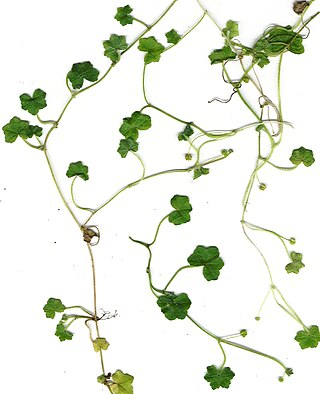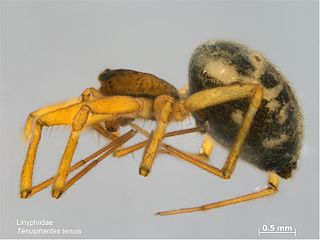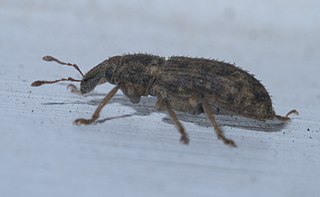
Salvinia molesta, commonly known as giant salvinia, or as kariba weed after it infested a large portion of Lake Kariba between Zimbabwe and Zambia, is an aquatic fern, native to south-eastern Brazil. It is a free-floating plant that does not attach to the soil, but instead remains buoyant on the surface of a body of water. The fronds are 0.5–4 cm long and broad, with a bristly surface caused by the hair-like strands that join at the end to form eggbeater shapes. They are used to provide a waterproof covering. These fronds are produced in pairs also with a third modified root-like frond that hangs in the water. It has been accidentally introduced or escaped to countless lakes throughout the United States, including Caddo Lake in Texas, where the invasive species has done extensive damage, killing off other life.

City Mill River is part of the Bow Back Rivers in London, England. It formerly fed City Mill, used for the production of chemicals in the late nineteenth and early twentieth centuries. In the 1930s, the mill was removed and the river was isolated from the tides by the construction of locks at both ends. City Mill Lock, at the southern end, has been refurbished and reopened in 2010.

Pennywort is a common name given to several different plants around the world. In general they have round leaves and a low-growing habit. Pennywort may refer to:
The mottled water hyacinth weevil, Neochetina eichhorniae, is a beetle that has been introduced as a biological pest control herbivore agent to waterways and lakes in countries worldwide to control the spread of the invasive noxious weed species Eichhornia crassipes, the water hyacinth, an aquatic plant native to the Amazon basin.

Neochetina is a genus of weevils known as water hyacinth weevil which are native to South America.

Hydrocotyle, also called floating pennywort, water pennywort, Indian pennywort, dollar weed, marsh penny, thick-leaved pennywort and white rot, is a genus of prostrate, perennial aquatic or semi-aquatic plants formerly classified in the family Apiaceae, now in the family Araliaceae.

Hydrocotyle ranunculoides, known commonly as floating pennywort, or floating marshpennywort, is an aquatic plant in the family Apiaceae. It is native to North and South America.

Cabomba caroliniana, commonly known as Carolina fanwort and various other names, is an aquatic perennial herbaceous plant native to North and South America. Having been a popular aquarium plant, it has been exported around the world, and has become an invasive species in Europe and Australia.

Cyrtobagous salviniae is a species of weevil known as the salvinia weevil. It is used as an agent of biological pest control against the noxious aquatic plant giant salvinia.

Islands, such as the British Isles, can be adversely affected by the introduction of non-native species. Often an island will have several distinct species not present on the nearest mainland, and vice versa. The native flora and fauna of islands which have been isolated for a longer period of time such as New Zealand or Hawaii are more vulnerable than islands such as Great Britain and Ireland, which became isolated more recently.

Parthenium hysterophorus is a species of flowering plant in the family Asteraceae. It is native to the American tropics. Common names include Santa-Maria, Santa Maria feverfew, whitetop weed, and famine weed. In India, it is locally known as carrot grass, congress grass or gajar ghas or dhanura. It is a common invasive species in India, Australia, and parts of Africa.

Salvinia minima is a species of aquatic, floating fern that grows on the surface of still waterways. It is usually referred to as common salvinia or water spangles. Salvinia minima is native to South America, Mesoamerica, and the West Indies and was introduced to the United States in the 1920s–1930s. It is classified as an invasive species internationally and can be detrimental to native ecosystems. This species is similar to but should not be confused with giant salvinia, Salvinia molesta.

Tenuiphantes tenuis is a species of spider belonging to the family Linyphiidae. Its native distribution is reported as Europe, Macaronesia, Northern Africa, Turkey, Caucasus, Central Asia. The species was introduced to USA, Chile, Argentina and New Zealand from Europe where it is found throughout.

Listronotus bonariensis is a species of weevil that is native to South America and is commonly known as the Argentine stem weevil. It is a pest of grasses and cereals, with the larvae being more destructive than the adult insects. It has spread to Australia and New Zealand, where it is regarded as a pest species.

Listronotus is a genus of underwater weevils in the family Curculionidae. There are at least 100 described species in Listronotus.
Listronotus humilis is a species of underwater weevil in the beetle family Curculionidae. It is found in North America.
Listronotus oregonensis, the carrot weevil, is a species of weevil in the beetle family Curculionidae. It is found in North America.
Listronotus tuberosus is a species of underwater weevil in the beetle family Curculionidae. It is found in North America.
Listronotus punctiger is a species of underwater weevil in the beetle family Curculionidae. It is found in North America.














